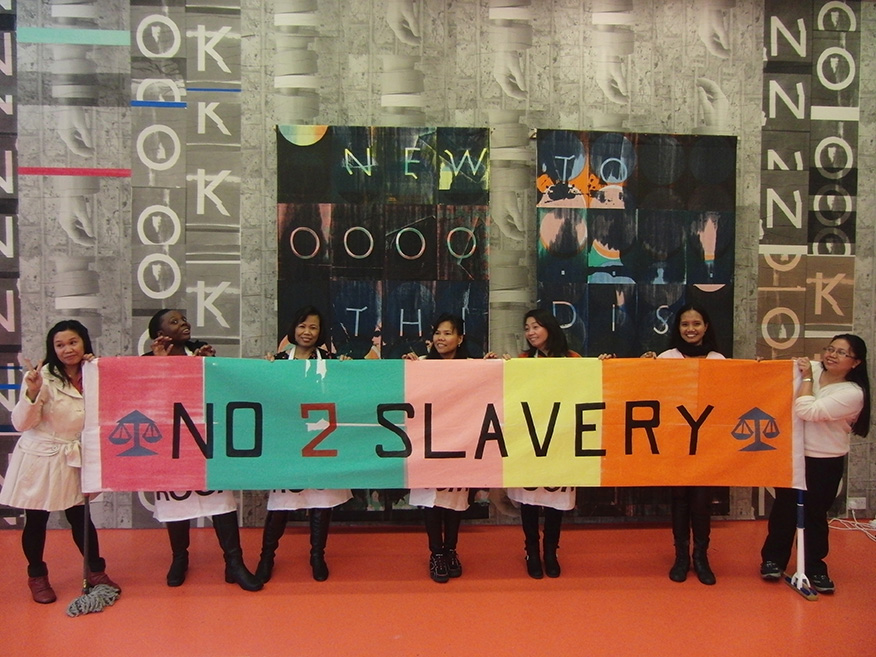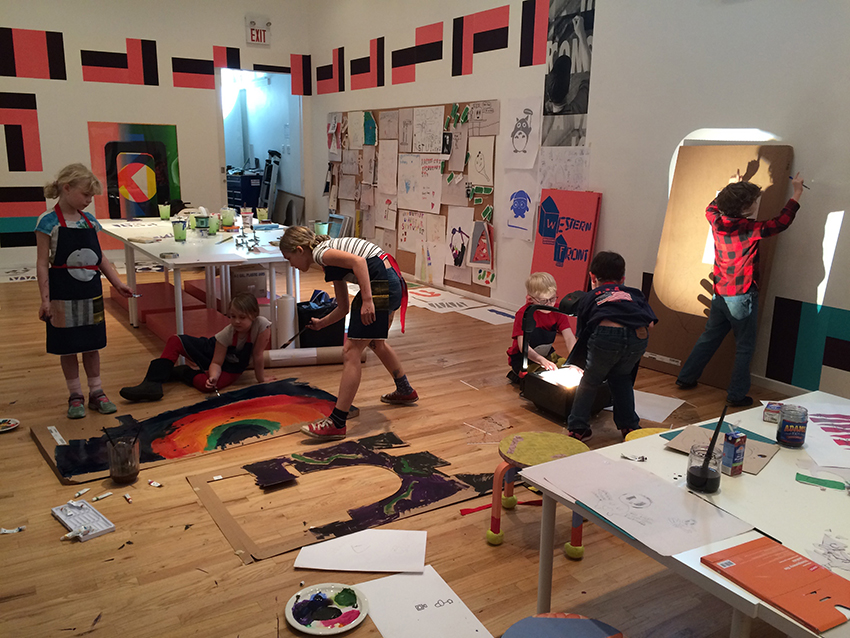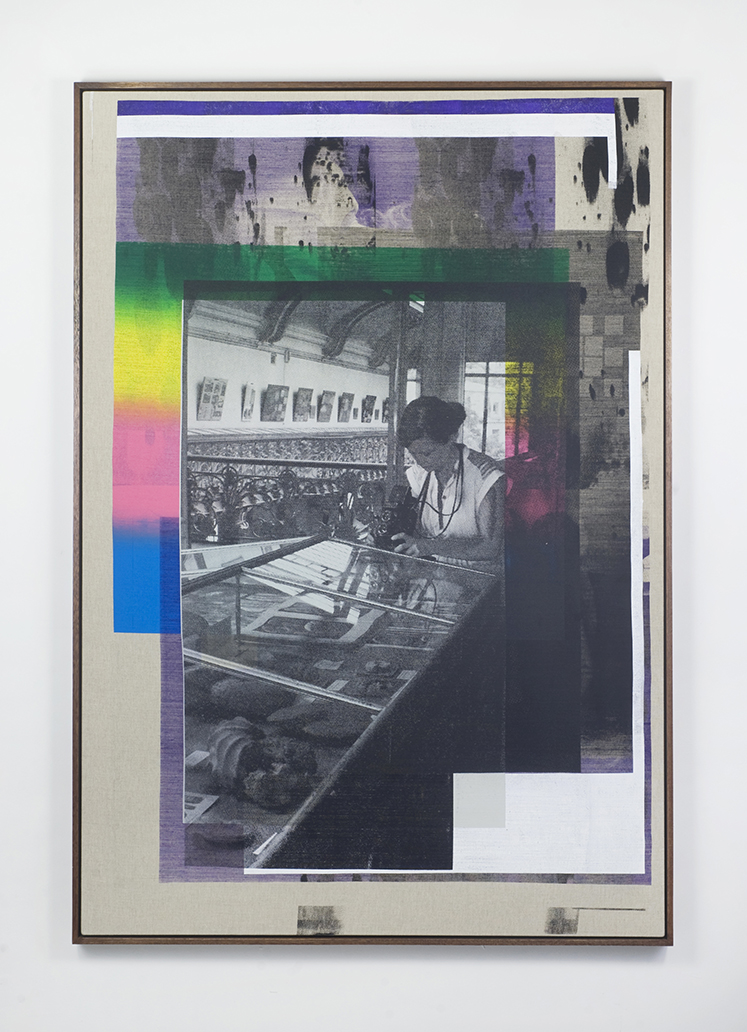Ciara Phillips
by Melissa Gronlund
Commissioned for Free Hot Mess, published by Agnes Etherington Art Centre, 2022.
There are things that take time. It takes time for one’s eyes to adjust to darkness. It takes time to cook. It takes time to watch a film. It takes time to look at all the parts of a picture.
This quite banal observation is increasingly forgotten. The expression now is to “clock.” “I’ve clocked it,” you might say of a video, meaning you opened it on Vimeo, watched twenty seconds of it, and then checked your email. “I know what her work is about.” The visual emblem of the clock face replaces the movement of the hands around its numbers. We feel we can see everything at once. Images seem easier to clock than words; Contemporary Art Daily, the image- driven art site, becomes more popular than Artforum.
The sensation of time passing, when it occurs, feels so alien that it is often described as “magical,” as in performances that require bodies to remain in a room for a long time together. Time has not only a transformative but other- worldly quality; duration becomes a surprise. But how precisely does this happen? How does experience change when we are in one room together? What are the determining effects of shared space on subjectivity? Duration was theorised as a material in the 1960s and 1970s by artists such as Andy Warhol and the Structuralist filmmakers in New York. Warhol’s twelve-hour Empire (1964), for example, brought people into the room together to watch his static film of the Empire State Building, reducing the affect of the situation to such a minimum that the phenomenological effects of sitting in one place for a long time came to the forefront of the audience’s minds. My butt hurts! People are loud breathers!
How has this understanding of duration changed in the digital era? Though I love a bit of Luddite hand-wringing, here I’m not joking: I truly believe that the experience of time is being transformed by the addictiveness of smartphones and social media, if simply because the opportunities for sustained absorption and boredom – which motivated the types of durational experiments above – no longer exist. Why sit staring at a poster for a disease you don’t have in a doctor’s office when you could check Facebook? Why stare out the window when you can check the news?
It is within this context that I want to think about Ciara Phillips’ work, and particularly how her challenge to traditional modes of art- and exhibition-making react to and are changed by new conceptualisations of time in the digital era. Time becomes a key means of accessing new forms of social relations, of privileging collectivity over individuation, and of understanding moments as spatial as much as temporal.
Phillips is best known for her collective experiment, Workshop (2010–ongoing), which reconfigures the set-up of the exhibition along the lines of social practice. In each iteration of the project, she transforms her exhibition into a place of production, using the duration of the show to make work with different groups she has invited to collaborate with her. At The Showroom in London in 2013, for example, she worked with the social activist group Justice for Domestic Workers [recently renamed The Voice of Domestic Workers], making an enormous banner with them that the group continues to use in rallies, which reads “No 2 Slavery.” In 2016, she worked with children for the first time, at Western Front in Vancouver, bringing their restive imaginations into the activity of choosing slogans, typesetting them, and then printing them as posters.

Ciara Phillips and Justice for Domestic Workers, No 2 Slavery, 2013
Commissioned by The Showroom, London
Photo: Ciara Phillips
Commissioned by The Showroom, London
Photo: Ciara Phillips

From the exhibition Cold Friends, Warm Cash, 2016
Commissioned by Western Front, Vancouver
Photo: Ciara Phillips
Commissioned by Western Front, Vancouver
Photo: Ciara Phillips
Workshop sets Phillips in a tradition of participatory, critical exhibitions that redefine the maker-object-seller triad that structures modern and contemporary art. Exhibition becomes production; the unique object becomes reiterative. Phillips deliberately looks back to this tradition, exploring historical moments and exponents that have also ran obverse to this triad. In her own screen-printing practice, which continues alongside Workshop, she has referenced, for example, the activist Sister Corita Kent, who made bright and beautiful screen-prints disseminating her message about social justice, and Gunilla Lundahl, a Swedish journalist who worked with Palle Nielsen on his The Model – A Model for a Qualitative Society (1968), when Nielsen turned the Moderna Museet in Stockholm into a giant playground. How can we think differently, Phillips asks, about the role of the exhibition vis-à-vis its public, and how can we activate the public to become part of the process of production – rather than exhibition – in a mode of togetherness?
This last part seems to me especially key. Workshop is a means of critically reflecting on exhibition and commodity structures, as well as the political tradition of printmaking, but it is also a pretext for bringing people into a space to work on one task, alongside each other, or as part of a corporate project in which people lend their skills toward working with each other. This social dimension is as important as the implicit commodity critique that’s built into critical exhibition practice. Workshop questions the exhibition as a site of social relations: a carved-out space and time in which relations between members of different publics can be reshaped and tested.
It also underlines how changing social relations is a mode dependent on time. Though it sounds obvious to point this out, it takes time for people to get used to each other, and to work together meaningfully, and Phillips has frequently stressed this dimension of the project in speaking about it.1 More recent exhibitions and iterations of Workshop have made this temporal dimension more explicit as a constituent part of the work itself. While Workshop has always indexically marked the duration of time through the exhibition, by the changing prints hung on the wall, Phillips’ installation at the Agnes Etherington Art Centre in Kingston, Ontario made time a visible facet of the exhibition. She painted the walls into a trompe-l’oeil representation of lines of tape, placed into a gridded pattern. The installation calls to mind, perhaps, the popular imaginary of cyberspace or the space-time continuum, which are conventionally represented by the superimposition of geometric lines onto an idealised visual field. The screen-prints Phillips hung on these walls thus appeared situated both in place and time, and the exhibition itself represented not only an occupation of space but of a specific duration.
Other installations of her screen-prints have foregrounded time by giving the impression of situating the viewer in a halted film reel. Strips of screen-prints, frequently in black-and-white, show repeated images running up and down the wall, as, for example, in her installation for the British Art Show 8 in 2015–17. These works evoke celluloid film strips and the negotiation between the representation of time and movement that has been embedded in filmic discourse since its origins. In the pivotal moment of Dziga Vertov’s Man with a Movie Camera (1929), a film editor, sitting at her desk, holds the film strip that she is working on up to the camera. The camera zooms into the frame, which shows a little blond girl with a bow in her hair; then, as if by magic – a simile used advisedly – she begins moving, and the film strip held by the editor becomes the reel of the Vertov film we ourselves are watching. It’s a perfect moment of formal self-reflexivity, emphasising how time and motion, in the new medium of film, are suddenly artistic materials to hand.
Motion, too, feels on the verge of Phillips’ work, held just back in abeyance by her static medium. Often her shows are loud and messy; her bright colour clash or the processes of Workshop result in paper and ink lying on the floor. It’s a busy sort of stillness. In 2016 Phillips embellished a boat in Leith harbour in Edinburgh, as part of a public art series that looked at the practice of “dazzle ships.” The effect is not aimed at camouflaging ships but at distorting their appearance when viewed through a periscope, using bright blocks of colour and differing shapes that make it difficult to see the direction in which the ship is travelling. Phillips covered the tender ship MV Fingal in a sharp-edged pattern, painted in retro-reflective grey, black, pink, blue and yellow, giving the impression of movement in any direction as the ship stays still. The pattern, if you can decode it, emits a message in Morse Code: “Every woman a signal tower.”

Every Woman: Dazzle Ship Scotland, 2016
Commissioned by Edinburgh Art Festival and 14-18 NOW
Photo: Ross Fraser McLean
Commissioned by Edinburgh Art Festival and 14-18 NOW
Photo: Ross Fraser McLean
The idea that motion is part of the work itself recalls Pamela Lee’s book Chronophobia, where she details the experiments of the 1960s in using time.2 Duration has been historically used to counter “autonomous” art – a late twentieth-century term that encompasses high art, circulation on the art market, Kantian nonpurposiveness, and which often refers specifically to the Greenbergian moment of Modernist painting. In Chronophobia, Lee particularly focuses her attention on the time experiments of 1960s Conceptualist artists, and argues, via a reading of Michael Fried’s “Art and Objecthood” essay, that duration is antithetical to the idea of autonomous art. Instead of sculpture and painting, she shows how Conceptualist and cybernetic work of the 1960s used systems and forms of automation that augured within them the expansiveness of time beyond the boundaries suggested by the artwork: they unfolded through time, rather than occupying a place in time.
Lee also illustrates how Fried’s essay was written in the shadow of film. It is a defence not only for a certain type of visual art-making, but for visual-art making as against filmmaking. Against the abstraction of Fried’s beloved Modernist painting, Lee underlines the fact that film replicates; it simply represents the world. It is an automated process both technologically and in terms of the images it produces, repeating what was there before. Automation, in this sense, is seen as art reduced to an informational or message system. Conceptualism and cybernetics, by zeroing in on duration and automation, were challenging the social grounds not only of high-art but also the bases of the definition that separated non-applied art from all other cultural forms.
If we can read “Art and Objecthood” in the shadow of film, we can return to the shadow that our current work lies under: that of the digital. The screen-print might seem to conform to Lee’s understanding of automatism, in its mechanical reproduction. Warhol, for instance, twinned its iteratibility to the idea of the simulacra, demonstrating the superfluous circulation of images by reproducing iconic images of already publicly available stars, such as Marilyn and Jackie O. But screen-printing now signals a different set of associations: it often points to affective resonances, labour in time, and manual production. For Phillips specifically, it means people in a space, and an activation rather than a performance of concerns. The use of the screen-printing technique suggests an authenticity of physical labour against the immateriality of digital labour. Rather than the alienation of the labourer that is read in digital technologies – in which the artist’s alienation from tactile sweat or his or her tools can be seen as a cypher for the alienation of immaterial labour more generally – the screen-printing tools allows for a connection between the artist and the product that he or she makes, in a profoundly compelling and emotional enterprise. It is bound up with the idea of the self as rooted to a place; a connection to authenticity not only of production but of self, of work that is satisfying rather than addictive or iterative, and whose labours are visible and visually understandable.
The importance of the emotional register is borne out by the crucial role affective relations play in Phillips’ “personal” printmaking practice. She often print images of close friends or makes ones that tell of private relationships. In Corin Looking (2015), she shows her friend, Corin Sworn, looking at an item within a glass display case. Sworn’s hair is worn up, knotted on the base of her neck in an almost nineteenth-century style, a reference point echoed by the Victorian- era museal environment she finds herself in – that of the Gallery of Palaeontology and Comparative Anatomy in Paris. Phillips’ image of Sworn is overlaid on different blocks of colour and of an enlargement of the first image, which are all then printed as one image. It is mediated, that is, by its own aestheticisation of the scene: it’s an image that talks about its construction. And Sworn’s engagement, too, is mediated; she holds in her hands a film camera, whose strap lies around her neck. Like Phillips, she is in the process of making material out of the museal material on show.

Corin Looking, 2015
Collection of Agnes Etherington Art Centre, Kingston, Canada
Photo: Alan Dimmick
Phillips frequently uses friends as models for her images, blows up personal
photographs to use them in a public exhibition context, or makes work in collaboration, as for the digital print Flagging Peace (2016) produced with her former
teacher, the artist Clive Robertson. The print reprises the letter “C” from her
name and his, and signals in semaphore the “N” and “D” of Nuclear
Disarmament and corresponds to the origins of the Peace Sign devised by
Gerald Holtom in 1958. It thus transverses the public space of these movements
by means of a private code, comprised by their own initials. In an earlier text
about Phillips’ work, I suggested its affinities to the idea of the “comrade
object,” the Russian Constructivists’ re-imagining of the object they produced
as not something for sale, but something that could redirect the affective and even libidinal desire sparked by the commodity fetish by making it the “friend”
of its possessor.3 In Comrade Objects (2016), Phillips explores this idea further,
making dress designs that allude to the Russian Constructivist Liulia Popova’s
degendered silhouettes for the emancipated communist woman. They stand in
the exhibition space like models, the type used in history museums, for another
past potential future. Like Workshop, whether by performing this critique or referring to historical examples of it, Comrade Objects attempts to understand the
art object as a site and index of affective, social relations.Collection of Agnes Etherington Art Centre, Kingston, Canada
Photo: Alan Dimmick
Where does this leave us and our subject of time? The gut feeling we have, faced with digital technologies, of our sense of time being under threat, is also of authentic social relations being endangered. Time is ceasing to be a social phenomenon. Instead, it is segmented into monetised fields of absorption, plied by social-media apps. Marshalling time in an artwork is no longer an affront to autonomous art but an attempt to colonise a social field, and to block it off as a site of collectivity rather than individuated consumption.
The movement of artists’ films from the cinema into the exhibition site brought with it a flurry of critique over the loss of a socially shared experience, of fixed duration, to one of sporadic engagement. I would argue that this shift is happening more generally now. The need to create the site and time parameters for authentic social relations to occur feels more pressing, whether in experiments such as those of Workshop, or of representing artwork specifically as a mode of social relations.
It’s worth asking how much of this is valid, and how much of this is a time-honoured response to new technologies, not unlike fears of the Gothic at the end of the nineteenth century. Indeed, focusing on technology alone in trying to account for the changes to everyday life blinds us to the larger context. In Pressed for Time: The Acceleration of Life in Digital Capitalism, the feminist scholar Judy Wajcman shows how not technology but shifting social conventions create the sense of time being accelerated.4 The bleeding together of work and leisure time, the demands and costs of childcare on families now that both parents must work, and the need for ever greater productivity in a competitive economy create the sense of being pressed, all the time. Phillips’ Workshop carves out a mode that runs averse to conventional exhibitions, and that creates temporal parameters that counter the idea of “time as money.” It opens a place for the activity of production rather than production itself. In this sense it attempts to understand how a different type of time can create – or recreate – a different kind of social production. Time becomes about the people, not about the things.
1. Conversation with the artist, July 2014.
2. Pamela M. Lee, Chronophobia: On Time in the Art of the 1960s, Cambridge, Mass.: MIT Press, 2004.
3. Melissa Gronlund, “Comrade Objects,” Just You (exh. cat.), Bergen: Bergen Kunsthall, 2014, accessible at https://www.ciaraphillips.com/index.php/more/ texts/.
4. Wajcman, Judy. 2015. Pressed for Time: The Acceleration of Life in Digital Capitalism. Chicago: The University of Chicago Press, 2015.